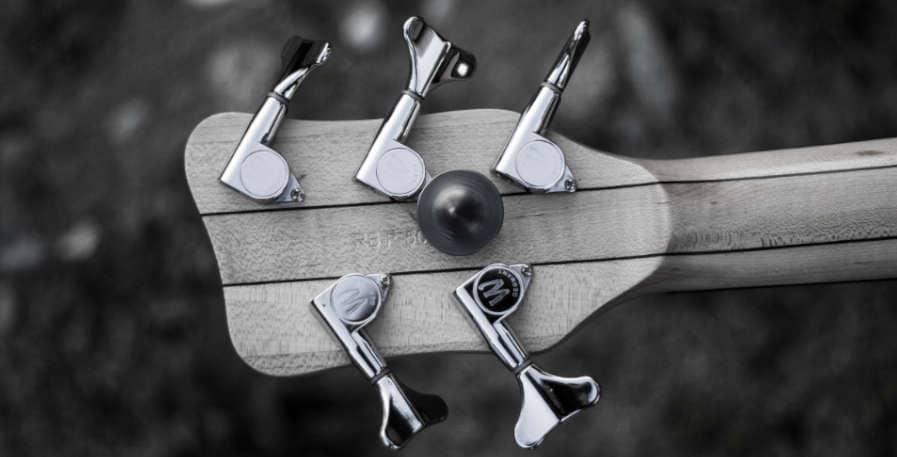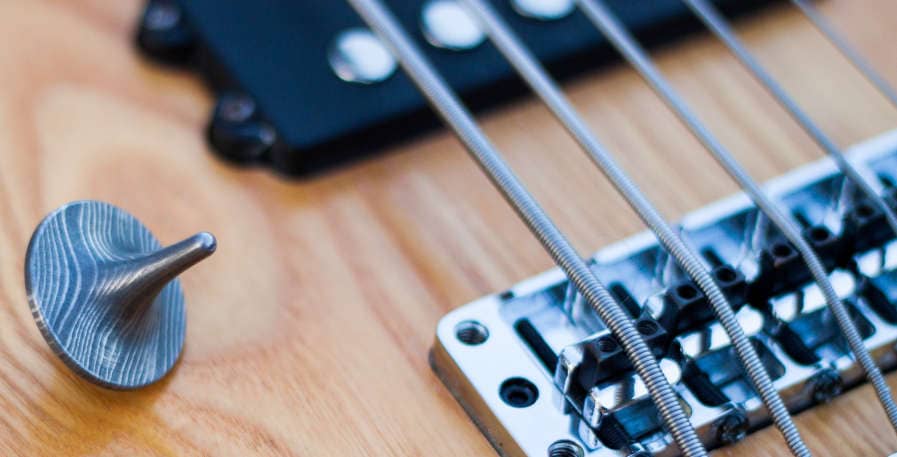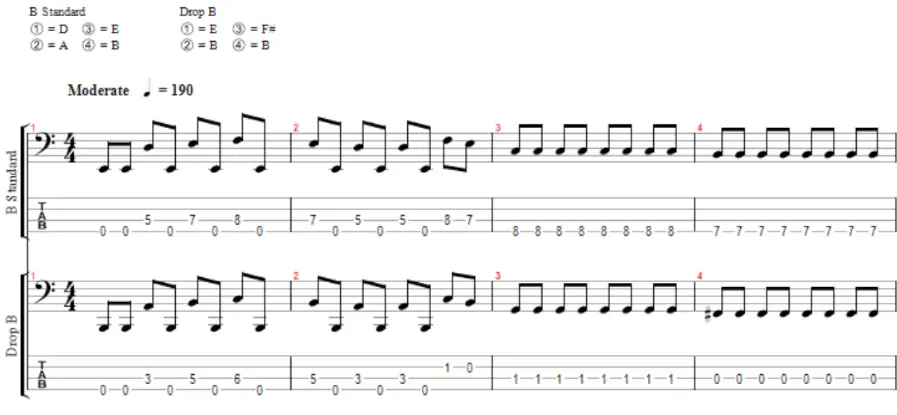This post contains affiliate links
Drop B is a common alternate bass tuning in the modern landscape of heavy music. While not as widely used as Drop D or C, it can sound incredibly heavy and powerful when used to its full potential.
Tuning a bass down to Drop B is however not as simple as just turning the tuning pegs a couple of steps. Switching to this low of a tuning requires your bass to be set up for it properly, at least if you want it to sound good.
When I tuned my bass down for the first time over a decade ago I wasn`t aware of this. As a result, I couldn`t understand why my bass sounded clicky and weak, and why it was so hard to play.
Luckily, you won`t have to make the same mistakes I made back then.
I`ve written this guide to showcase what you need to do to get a resonant and heavy tone while keeping your instrument easy to play. I have also made a tuner so that you can easily tune to Drop B once you have done this. You will also learn what the pros and cons of this tuning are, and when it is a good idea to choose it over other options.
What tuning is drop B on bass?
In Drop B, a 4-string bass is tuned B-F#-B-E. 5-string basses are less commonly tuned to Drop B as it requires the bass to be tuned up from B standard. The strings can however be tuned up to B-F#-B-E-A to tune achieve a Drop B tuning.
The “B” in Drop B refers to what pitch the deepest string is tuned to. “Drop” means that the deepest string is tuned a perfect 5th apart from the next string, rather than a perfect 4th. The name comes from it being “dropped down” an additional whole step.
Of other tunings, Drop B is most resemblant of C# standard as they share an F#, B, and E string. In B standard, the strings are tuned B-E-A-D, and these tunings thus only have the deep B string in common.
Bassists choose to tune to Drop B for several reasons. Here are the most common ones:
- To sound noticeably heavier – Tuning to Drop B makes it possible to sound heavier than most bands out there. This is because when bands tune down they commonly tune to Drop C, Drop D, or to Eb standard. As Drop B is deeper than the most common alternate bass tunings, it is a great tuning for sounding noticeably heavy in the current landscape of music.
- Modern Hard Rock Sound – Drop B is used in various genres of heavy music. Some examples include metalcore, symphonic metal, and nu-metal. However, the tuning has also been used by bands that play hard rock, where tuning this low is less conventional. Bands like Chevelle and Asking Alexandria have made great use of Drop B to provide an incredibly heavy backdrop to catchy choruses with clean vocals. This blends into a sound that feels modern and has helped bring these bands major commercial success.
- To match the 4-string bass with the 7-string guitar – 7-string guitars and 5-string basses are most commonly tuned to B standard. Bassits that play a 4-string bass in a band with 7-string guitar players, thus often opt to tune to either Drop B or B standard to match the deep range of the guitar players.

How do you tune a bass to Drop B?
When tuning down your bass more than a half-step or two, it is crucial to set the bass up for the new tuning. Skipping these steps will negatively impact both the playability and tone of your instrument.
The great news is that all these steps are easy to perform at home. Alternatively, you can opt to pay a professional luthier to do it for you.
If you get someone else to set up your bass, I recommend reading my article on the average cost of a bass setup.
Here are the steps you need to take to set up your bass for Drop B:
- Switch strings – While a 5-string bass can handle drop B decently well without a string change, a 4-string bass will need a new set. With a set intended for E standard, the strings will be too sloppy and tensionless to play. They will also sound clanky and metallic, lack resonance and sustain, and lack the punch and power you want when tuning down. String choice is covered more in-depth below.
- File the nut – The heavier strings mentioned above are unlikely to fit into the nut of your bass. Thus, you will need to file the cuts in it to fit the new strings. If the strings don`t fit properly into the cuts in the nut, they will feel unstable, and they will impact the intonation and action of your bass.
- Adjust the action – On a bass, action refers to the space between the frets and strings. In general, bassists prefer keeping the action low for the sake of making strings easier to fret. After tuning down to Drop B, it is common to experience that the action has risen. Thus, it is a best practice to adjust it with a truss rod adjustment. This adjustment will also help you adjust the neck relief on your bass.
- Retune the strings regularly – After tuning down, your bass will take some time to get used to the new tuning. As a result, you might need to tune your bass more often than you are used to. This need to tune the bass will diminish over time, and it`s a normal part of switching to a new tuning.
Drop B Bass tuner
To make tuning to Drop B easier for you, I made a tuner that you can use below.
Play the pitches below and match them to that of your strings one after another, starting with the deepest string. I`ve also added a high A for 5-string players looking to tune their bass to B-F#-B-E-A.
If you struggle to match the pitches, you can choose to use an online tuner with a microphone instead. The tuner will show you exactly what pitch is being played. This is a great way to ensure that you are perfectly in tune if you find tuning by ear difficult.

What string gauge is best for drop B?
In Drop B, a balanced set of bass strings has gauges of approximately .135-.090-.067-.050. These gauges can be adjusted slightly to attain a heavier or thinner sound while retaining the playability of the bass. Roundwound strings are generally used in Drop B for their bright and powerful tone.
When tuning to Drop B, Ernie Ball recommends string gauges of .125-.060 for 4-string basses. A set like this will work, but it is on the thinner side of what gauge strings most bassists use for this tuning.
For the low B string, it is common to use strings in the .130 to .145 range, with some bassists going even thicker. I`ve only tried to play in this tuning with a .135 for the low B, and I found that this gave me a great balance between string tension and resonance.
Thus, depending on your preferences, a string in the .125-.145 range will work. My personal recommendation is to use a .135 if you are unfamiliar with the tuning and are looking for a balanced sound. For the whole set, .135-.090-.067-.050 gauges will balance out the rest of your strings well with the low B. For 5-string players recommend a .040 for the high A.
The challenge when purchasing strings, are that most sets are designed for standard tunings. Thus, the best course of action is often to get a single string for the deepest string and to get a set of strings that compliments it.
I found the best way to go about this is to get a single D’Addario .135 string.
Then, combine this with a .120-.090-.067-.050 set from the same manufacturer.
This will leave you with an unused .120 string, which is replaced by the .135 for the low B. I recommend storing the .120 string away, as it could come in handy for other alternate tunings such as C Standard or Drop C.
Both the single string and the set linked above are roundwound with nickel-plated steel, which makes for a bright and powerful tone. This is perfect for the type of heavy and resonant sound most bassists are looking for when tuning down to B.
What bands use B standard tuning?
Like most deep alternate bass tunings, Drop B is most commonly used by rock and metal bands. Drop B in particular is particularly prevalent among hard rock and metalcore acts.
Below is a list of 10 bands and bassists that have played in the tuning at some point. Note that many of these bands have changed their sound over time. Thus, the genre labels below will only give a surface-level idea of their sound
You can use the list to get a broader grasp on what Drop B can sound like, and what it can be used for. The list is also a great way to gather inspiration and for finding music to cover.

Drop B VS B Standard
The only string that is tuned the same in B standard and Drop B is the low B. In B standard the strings are tuned B-E-A-D, which means all the other strings are tuned 1 whole step higher than in Drop B.
In terms of range, Drop B provides 1 whole step more of high range than B Standard. This difference is largely inconsequential, and the real difference between the two tunings lies in how they affect the playability and fretboard of your bass.
The advantage of B standard is the very fact that it is a standard tuning.
This means that every string is tuned a perfect 4th apart. As a result of this, you can reach most notes without having to change the position of your fretting hand. This makes playing easier and retains your muscle memory if you are used to playing in E.
The advantage of Drop B is that it makes it convenient to play with guitar players that utilize the same tuning. While riffs that are written for Drop B can generally be played in B standard as well, transposing them leads to extra work, and can make some riffs harder to play.
Below is an example of a metal riff played in both B standard and Drop B. While some riffs can lead to awkward finger patterns when switching between the two tunings, the differences in riffs are generally minor:

Conclusion
Drop B is a fitting bass tuning for bassists who feel that C and D simply don`t provide enough punch. It is also a great tuning for hard rock and metalcore bassists who are looking for a heavy and modern bass tone.
The most important part of tuning down is to find a fitting set of strings and set up your bass properly. With string gauges of .135-.050 for 4-strings and .135-.040 for 5-strings, you will have a set that sounds balanced and feels natural to play.
You will likely need to file the nut and adjust the truss rod on your bass for the sake of neck relief and action after tuning down. You can do this yourself at home, or you can pay a luthier to do it for you. Regardless of whether you set your bass up yourself or get someone to do it, you should not skip these steps; they will greatly impact the playability and tone of your instrument.
Once you have done this, all you need to do is plug in your bass and play. While you might have listened to bands that play in Drop B before, I can promise you that nothing will beat the sound of hitting that low B yourself for the first time.
While B standard is “The 5-string bass tuning”, Drop B is more commonly used by 4-string players. I have seen this spark some debates between metal musicians over whether a 4-string or 5-string is best suited for the genre. I took a deeper look into the topic in my article on whether you need a 5 string bass for metal.

